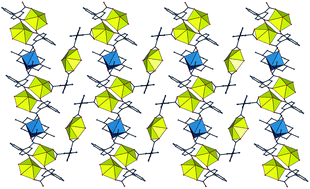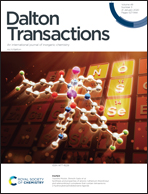Zero-, mono- and diperiodic uranyl ion complexes with the diphenate dianion: influences of transition metal ion coordination and differential UVI chelation†
Abstract
Diphenic acid (H2dip) has been used to synthesize nine homo- or heterometallic uranyl ion complexes under solvo-hydrothermal conditions. The diphenate ligand dip2− adopts different coordination modes, mixtures of κ2-O,O′-chelation by individual carboxylate groups, chelation involving both carboxylate groups, and bridging, resulting in different associations of the cations present. [UO2(dip)] (1), [UO2(dip)(bipy)] (2), and [UO2(dip)(phen)] (3) crystallize as monoperiodic coordination polymers, complex 1 with the bridging and both chelation modes of the ligand, and 2 and 3 with only the bis-κ2-O,O′-chelated mode and further chelation by 2,2′-bipyridine (bipy) or 1,10-phenanthroline (phen). The two isomorphous complexes [H2NMe2]2[(UO2)2(dip)3] (4) and [(UO2)2Ag2(dip)3(H2O)(CH3CN)] (5) display ladder-like monoperiodic arrangements with the hydrogen bonded H2NMe2+ or carboxylate-bound, decorating Ag+ cations occupying similar positions within the chains. [Ni(R,S-Me6cyclam)(H2O)2][UO2(dip)2] (6) contains a discrete dianionic mononuclear species, while [(UO2)2(dip)2(Hdip)2Ni(cyclam)]·2H2O·2CH3CN (7) crystallizes as a monoperiodic, heterometallic polymer, with further formation of layers through reciprocal hydrogen bonding of the carboxylic acid groups. A discrete dinuclear dianionic complex is present in [Cu(R,S-Me6cyclam)][UO2(dip)(NO3)]2 (8), which crystallizes together with [(UO2)3(dip)4Cu(R,S-Me6cyclam)(H2O)2]·6H2O (9), a diperiodic assembly in which uranyl-containing dimeric units are assembled in chains through diaxial carboxylate coordination of Cu(R,S-Me6cyclam)2+ cations, with further bridging by uranyl cations generating a network with the fes topology. The uranyl emission spectra of complexes 3, 4 and 5 show the usual vibronic fine structure, while uranyl emission in 7 is largely quenched.



 Please wait while we load your content...
Please wait while we load your content...